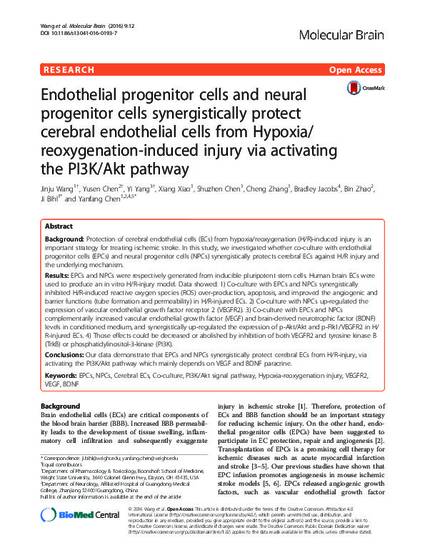
Background
Protection of cerebral endothelial cells (ECs) from hypoxia/reoxygenation (H/R)-induced injury is an important strategy for treating ischemic stroke. In this study, we investigated whether co-culture with endothelial progenitor cells (EPCs) and neural progenitor cells (NPCs) synergistically protects cerebral ECs against H/R injury and the underlying mechanism. Results
EPCs and NPCs were respectively generated from inducible pluripotent stem cells. Human brain ECs were used to produce an in vitro H/R-injury model. Data showed: 1) Co-culture with EPCs and NPCs synergistically inhibited H/R-induced reactive oxygen species (ROS) over-production, apoptosis, and improved the angiogenic and barrier functions (tube formation and permeability) in H/R-injured ECs. 2) Co-culture with NPCs up-regulated the expression of vascular endothelial growth factor receptor 2 (VEGFR2). 3) Co-culture with EPCs and NPCs complementarily increased vascular endothelial growth factor (VEGF) and brain-derived neurotrophic factor (BDNF) levels in conditioned medium, and synergistically up-regulated the expression of p-Akt/Akt and p-Flk1/VEGFR2 in H/R-injured ECs. 4) Those effects could be decreased or abolished by inhibition of both VEGFR2 and tyrosine kinase B (TrkB) or phosphatidylinositol-3-kinase (PI3K). Conclusions
Our data demonstrate that EPCs and NPCs synergistically protect cerebral ECs from H/R-injury, via activating the PI3K/Akt pathway which mainly depends on VEGF and BDNF paracrine.
Available at: http://works.bepress.com/ji_bihl/30/

© 2016 Wang et al. Open Access This article is distributed under the terms of the Creative Commons Attribution 4.0 International License (http://creativecommons.org/licenses/by/4.0/), which permits unrestricted use, distribution, and reproduction in any medium, provided you give appropriate credit to the original author(s) and the source, provide a link to the Creative Commons license, and indicate if changes were made. The Creative Commons Public Domain Dedication waiver (http://creativecommons.org/publicdomain/zero/1.0/) applies to the data made available in this article, unless otherwise stated.